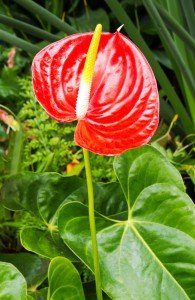Kalapana is the name of the town located on the Southeastern end of the Island of Hawaii, which gained notoriety in 1986 when the most recent volcanic episode covered the town with lava.
Kalapana was also the name selected by the University of Hawaii College of Tropical Agriculture in the 1980’s as the first patented cultivar they released to the industry. We selected this specific Anthurium because it is known for its base color of red, its wavy shape which gives it a unique appearance, its greenish “ears,” and its excellent size. Kalapana is one of about 800 species of the Anthurium Genus belonging to the Arum family. The anthurium is native to Central and South America, but is grown virtually worldwide in damp tropical rain forest environments. In Hawaiian, “Okika” stands for “Orchids,” which accent and contrast with the Kalapana Anthurium in this month’s bouquet. This particular cultivar was created by the University of Hawaii College of Tropical Agriculture in the 1970’s, and is known as the Jaquelyn Thomas Dendrobium. While they come in various colors and shades, the white is the most prominent.
Following are some incidentals you may not know about the intriguing Anthurium plant:
- Anthuriums are popular as foliage plants, not just for their blooms. • This plant’s stem may grow to 20″.
- All parts of the anthurium plant are poisonous. If ingested, mild stomach disorders may occur. (Please keep away from young children and pets.)
- Be cautious if you have sensitive skin, as the sap can be a skin irritant. Wash your hands thoroughly with soap and water after arranging your stems. You may opt to wear gloves when handling.
- The Titan Arum (Amorphophallus titanum), a member of the Anthurium family, is the plant with the largest inflorescence (bloom) in the world.
So what might be the perfect greenery to spotlight these two beautiful flowers? How about a fern such as the False Staghorn with its distinctive light green color, and its quirky little “fiddleheads?” These little curly-cues announce the end of the growth on each particular frond.
Also known as the Uluhe fern, it begins as a purple coil that sprouts from the ground. As it unwinds and grows, it splits into two branches (or fronds). Those two fronds grow and split again, and the rhythm of growing and splitting continues. This split growth is referred to as a “bifurcating” pattern.
Because of the way some ferns grow, they are able to crawl up steep mountain sides and literally overtake large trees. When used in conjunction with the breathtaking Kalapana Anthurium and Okika Orchid, you can rest assured they won’t overtake them . . . just enhance and showcase their exotic beauty.
Special Care for Kalapana Okika Bouquets
When you receive your Bouquet at this time of year, we suggest that you immerse the stems in cool temperature water for about five minutes. This will help take any heat out of them.

Then cut about one-quarter of an inch diagonally off the bottom of each stem, using a very sharp knife to prevent stem damage. Place each in cool water before creating your arrangement.
To extend the shelf life of your bouquet to the maximum, please change the water every couple of days, and trim another one-quarter of an inch off the bottom of all stems. Misting the flower heads daily will keep the blooms hydrated, vibrant and healthy.
Please refrain from displaying your arrangement in direct sunlight, and avoid drafty areas.
How Long Your Bouquet Lasts Depends On . . .
1) How and when the flowers are harvested. These were cut in the early morning and soaked in a special solution to prepare for shipping. They are cut before they bloom so they will travel better.
2) Time: We ship overnight, bypassing long stops at both the wholesalers and the florists.
3) Hospitality: If you follow the instruction above, it will make a BIG difference.